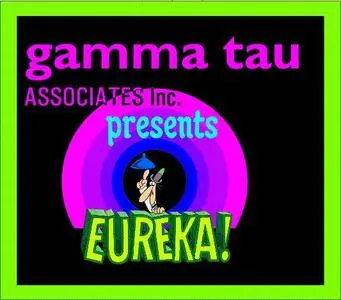EUREKA! - Science/Physics Series
PC | Win95 - XP | Edutainment | DAA | 1.4 GB | 3 CDs
PC | Win95 - XP | Edutainment | DAA | 1.4 GB | 3 CDs
Eureka! is a series of humorous, and information-packed programs that bring "boring" physics concepts to vibrant, vigorous life. Each program takes a simple and direct approach to the subject matter; while the basic concepts are explained in a voice-over, cartoon characters and a variety of animated objects demonstrate the principles on the screen. Constant review and reinforcement make the message clear; as a result, the study of physics becomes easier and accessible - even to viewers without a solid background in the subject.
Topics:
UNIT 1: Force and Energy
Program 1: Inertia
This program introduces the series and sets forth the concept of inertia, the first law of physics: Things like to keep on doing what they're already doing.
Program 2: Mass
Building on the concept of inertia, Eureka! adds the factor of mass, tells how it's measured, and shows how it differs from size. Concept: Inertia increases with mass.
Program 3: Speed
The concept of speed is introduced to the inertia-mass relationship. Concept: Force varies with mass and rate of change of speed.
Program 4: Acceleration I
With the examples of a bicycle and a baseball player, an important rule of physics becomes apparent. Concept: Force = mass x acceleration.
Program 5: Acceleration II
An animated locomotive helps explain how acceleration works and is calculated. The importance of reasonable units is stressed. Concept: Acceleration = m/s2
Program 6: Gravity
Isaac Newton's celebrated falling apple is cited to explain the force of gravity and the unit with which the force of gravity is measured. Concept: Force of gravity = mass x 10m/s2
Program 7: Weight vs Mass
Eureka! explains the difference between weight and mass, and shows how only mass is the same on the moon and on the earth.
Program 8: Work
A circus strongman and a clown help present the physics definition of work. Concept: Work = force x distance.
Program 9: Kinetic Energy
Animated billiard balls help demonstrate kinetic energy - the energy of motion.
Program 10: Potential Energy
A rock teetering on the edge of a cliff is shown to have potential energy - the energy of position.
––––––––––––––––––––––––––––––––––––––
UNIT 2: Simple Machines
Program 11: The Inclined Plane
This program demonstrates how an inclined plane allows you to trade increased distance for decreased force.
Program 12: The Lever
Eureka! demonstrates the principle of the lever: "The longer the arm of the lever to which force is applied, the less that force need be."
Program 13: Mechanical Advantage and Friction
Professors A and B compare the mechanical advantage of an inclined plane with that of a lever.
Program 14: The Screw and the Wheel
This program provides examples and definitions of a screw and a wheel; a screw is simply a twisted inclined plane; a wheel is simply a circular lever, whose fulcrum has become an axle.
Program 15: The Pulley
Eureka! shows viewers how a pulley works to lift a heavy object. If you double the number of ropes supporting the weight, you double the mechanical advantage.
––––––––––––––––––––––––––––––––––––––
UNIT 3: Heat and Temperature
Program 16: Molecules in Solids
This program defines the three states of matter, and illustrates the lattice-work pattern of molecules in solids. Viewers learn the origin of the word "molecule."
Program 17: Molecules in Liquids
As molecules in a solid get hotter, they vibrate faster and faster and eventually slip out of their lattice-work pattern. When this occurs, the substance melts, changing from a solid to a liquid state.
Program 18: Evaporation and Condensation
A goldfish bowl filled with water demonstrates the process of evaporation, in which speeding molecules escape from a liquid to form a gas.
Program 19: Expansion and Contraction
Using balloons to illustrate the process, Eureka! shows how, when matter gets hot, its molecules go faster and the solid, liquid, or gas expands. Conversely, when matter gets cold, its molecules go slower, and the solid, liquid, or gas contracts.
Program 20: Measuring Temperature
Eureka! shows viewers how Swedish scientist Anders Celsius invented the Celsius thermometer, using the expansion of mercury as a measure of temperature.
Program 21: Temperature vs Heat
Eureka! explains that heat refers to quantity of hotness, and is determined by the mass and speed of molecules. This program demonstrates that a bucket of water at a temperature of 50?C contains more heat than a cup of water at 100?C.
––––––––––––––––––––––––––––––––––––––
UNIT 4: The Conduction of Heat
Program 22: Atoms
This program explains that molecules are made up of atoms. In pure metals, all the atoms are arranged separately in a lattice-work pattern, but in most non-metals, liquids, and gases, the atoms are bunched together intomolecules.
Program 23: Electrons
Using an animated model of an atom, Eureka! illustrates how electrons whiz so quickly round the nucleus that they appear to form layers.
Program 24: Conduction
Eureka! looks at the process of conduction, explaining that the application of heat to an object makes the molecules or atoms vibrate faster and cause a sort of "domino effect."
––––––––––––––––––––––––––––––––––––––
UNIT 5: The Convection of Heat
Program 25: Volume and Density
This program explains that volume refers to the amount of space an object envelops and that density refers to the amount of mass that is compacted in a given volume.
Program 26: Buoyancy
Showing viewers that objects immersed in a liquid are buoyed up by a force equal to the weight of the liquid displaced, this program explains the principle of buoyancy.
Program 27: Convection
This program explains how the principle of buoyancy is responsible for the process of heat transfer called convection.
––––––––––––––––––––––––––––––––––––––
UNIT 6: The Radiation of Heat
Program 28: Heat as Energy
Heat is produced whenever there is movement and friction between two objects. Since movement is a form of energy, it follows that heat must also be a form of energy.
Program 29: Radiation Waves
Viewers learn that one of the chief ways in which heat energy moves is in the form of waves. This kind of heat transfer is called radiation.
Program 30: The Radiation Spectrum
Viewers learn that the waves of heat energy radiated by the sun come in many forms, which together make a band, or spectrum, of energy waves.
Download:
PC | Win95 - XP | Edutainment | DAA | 470 MB | CD 1 of 3
http://rapidshare.com/files/85453206/CG.E.1o3.part01.rar
http://rapidshare.com/files/85463426/CG.E.1o3.part02.rar
http://rapidshare.com/files/85470579/CG.E.1o3.part03.rar
http://rapidshare.com/files/85478693/CG.E.1o3.part04.rar
http://rapidshare.com/files/85485605/CG.E.1o3.part05.rar
http://rapidshare.com/files/85491438/CG.E.1o3.part06.rar
http://rapidshare.com/files/85497833/CG.E.1o3.part07.rar
http://rapidshare.com/files/85504828/CG.E.1o3.part08.rar
http://rapidshare.com/files/85510682/CG.E.1o3.part09.rar
http://rapidshare.com/files/85518319/CG.E.1o3.part10.rar
http://rapidshare.com/files/85525937/CG.E.1o3.part11.rar
http://rapidshare.com/files/85532414/CG.E.1o3.part12.rar
http://rapidshare.com/files/85539140/CG.E.1o3.part13.rar
http://rapidshare.com/files/85544612/CG.E.1o3.part14.rar
PC | Win95 - XP | Edutainment | DAA | 500 MB | CD 2 of 3
http://rapidshare.com/files/85549046/CG.E.2o3.part01.rar
http://rapidshare.com/files/85561431/CG.E.2o3.part02.rar
http://rapidshare.com/files/85565256/CG.E.2o3.part03.rar
http://rapidshare.com/files/85568314/CG.E.2o3.part04.rar
http://rapidshare.com/files/85571479/CG.E.2o3.part05.rar
http://rapidshare.com/files/85574481/CG.E.2o3.part06.rar
http://rapidshare.com/files/85577845/CG.E.2o3.part07.rar
http://rapidshare.com/files/85581848/CG.E.2o3.part08.rar
http://rapidshare.com/files/85584492/CG.E.2o3.part09.rar
http://rapidshare.com/files/85586783/CG.E.2o3.part10.rar
http://rapidshare.com/files/85589701/CG.E.2o3.part11.rar
http://rapidshare.com/files/85592479/CG.E.2o3.part12.rar
http://rapidshare.com/files/85595070/CG.E.2o3.part13.rar
http://rapidshare.com/files/85597562/CG.E.2o3.part14.rar
http://rapidshare.com/files/85599979/CG.E.2o3.part15.rar
PC | Win95 - XP | Edutainment | DAA | 410 MB | CD 3 of 3
http://rapidshare.com/files/85604048/CG.E.3o3.part01.rar
http://rapidshare.com/files/85613066/CG.E.3o3.part02.rar
http://rapidshare.com/files/85621406/CG.E.3o3.part03.rar
http://rapidshare.com/files/85627830/CG.E.3o3.part04.rar
http://rapidshare.com/files/85634357/CG.E.3o3.part05.rar
http://rapidshare.com/files/85659479/CG.E.3o3.part06.rar
http://rapidshare.com/files/85790314/CG.E.3o3.part07.rar
http://rapidshare.com/files/85793958/CG.E.3o3.part08.rar
http://rapidshare.com/files/85797564/CG.E.3o3.part09.rar
http://rapidshare.com/files/85800785/CG.E.3o3.part10.rar
http://rapidshare.com/files/85803935/CG.E.3o3.part11.rar
http://rapidshare.com/files/85806939/CG.E.3o3.part12.rar
http://rapidshare.com/files/85807054/CG.E.3o3.part13.rar
Password for all files: grafitti





